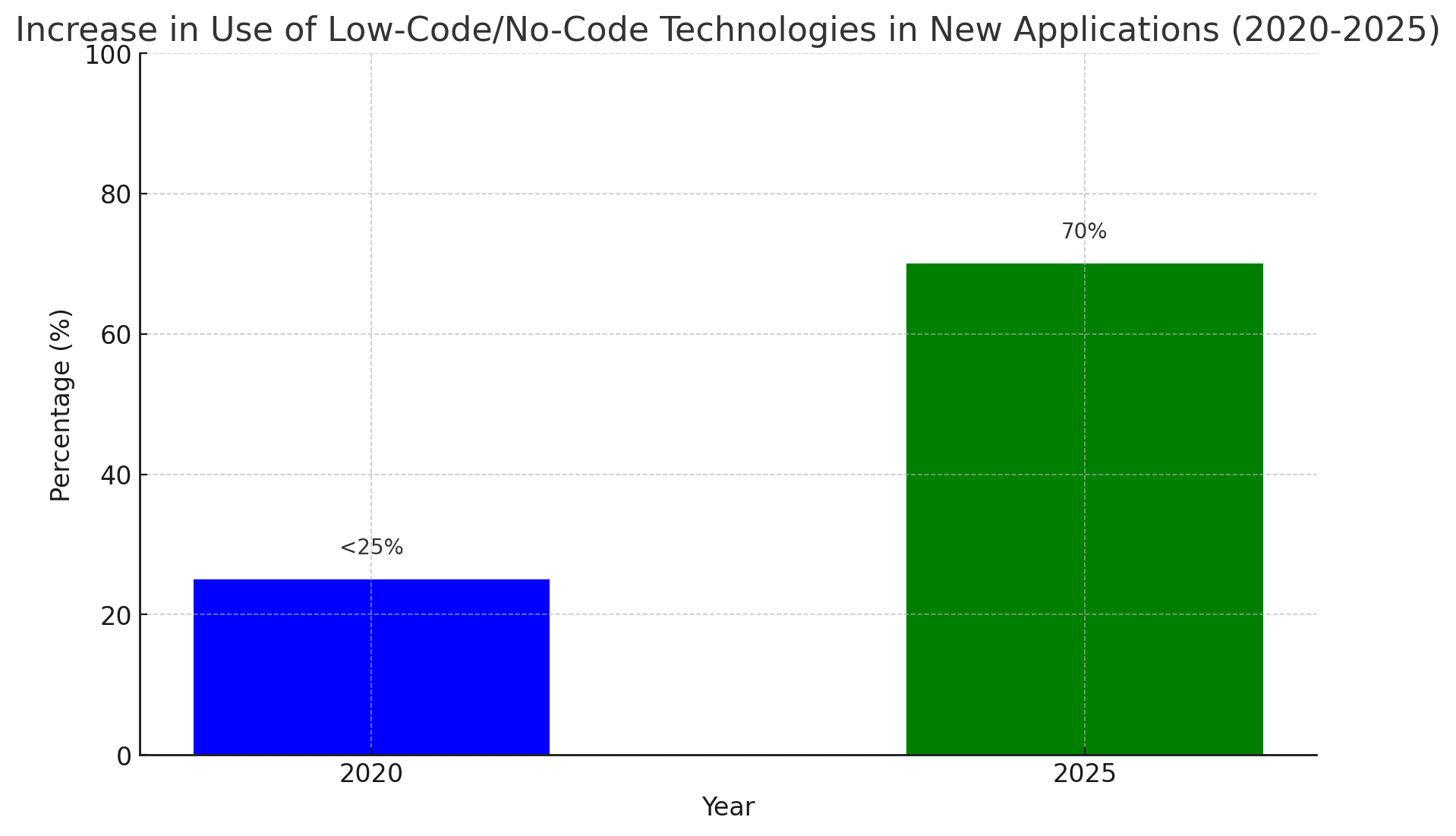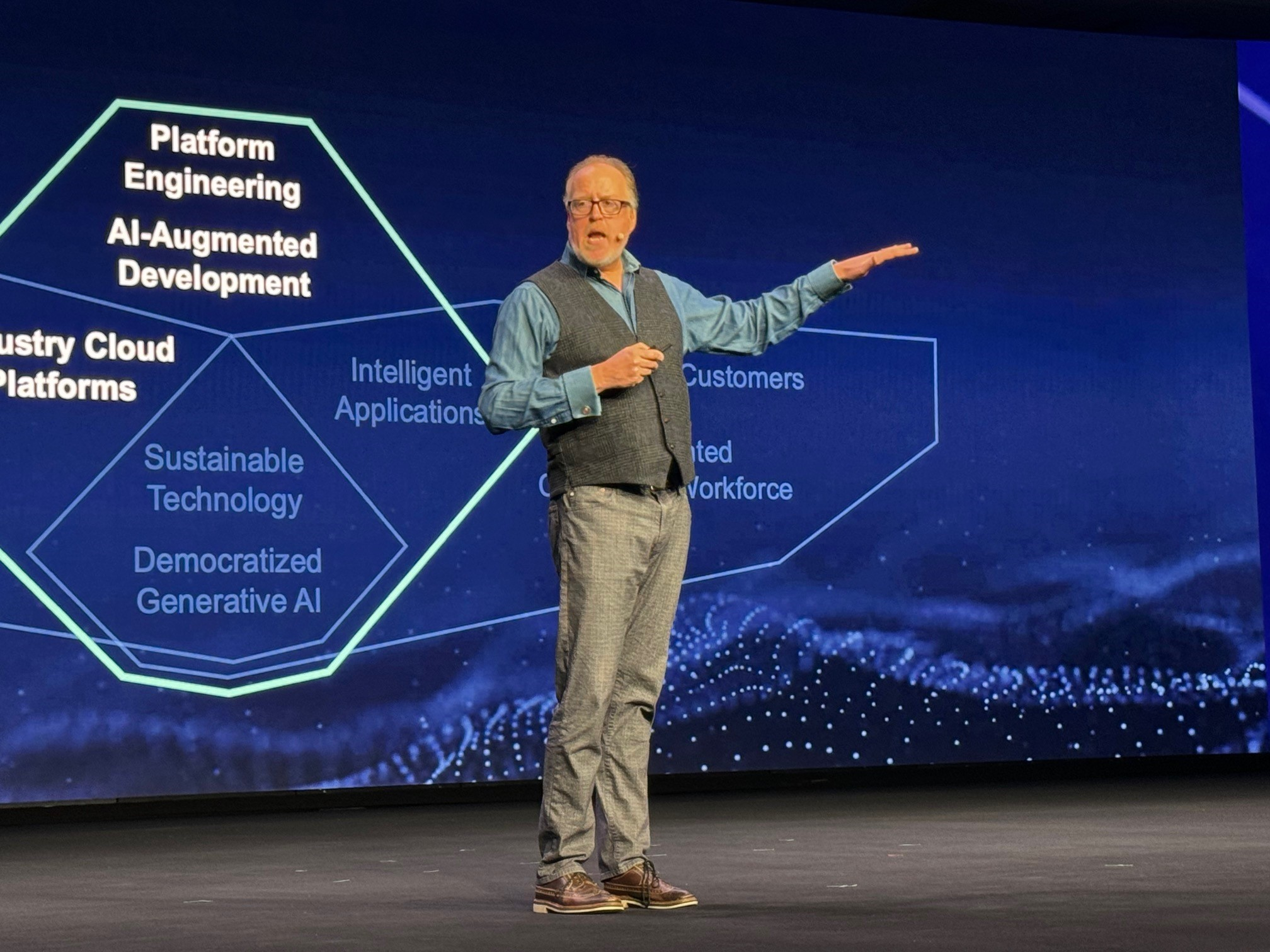
Top 10 Best Outsourced Product Development Companies
The year is 2024. Outsourcing, once the boogeyman of corporate development horror stories (“They took our jobs!”) has now become a badge of honor—a cunning strategy adopted...
2023 has been a good year for no code. As we enter 2024, the landscape of software development is continuing to undergo a paradigm shift with rise of this technology. No code is revolutionizing how we think about web and mobile app development, making it more accessible, efficient, and adaptable to a rapidly changing digital world.

Next year, no code will be a key driver of digital transformation, enabling businesses and individuals to effortlessly translate ideas into functional digital products. Let’s explore the burgeoning no code trends 2024 and this technology’s critical role in shaping the future of innovation.
No code movement will go on to redefine the landscape of app creation and business innovation by making software development accessible to a broader audience. Drag-and-drop elements and visual-based programming of no code platforms enable individuals without any coding experience to design, customize, and deploy applications.

The rise of these platforms is fostering a culture of creativity and experimentation. Individuals and organizations can now test new ideas without the substantial time and financial investment traditionally associated with software development.
This not only accelerates innovation but also encourages a more inclusive and collaborative approach to technology development.
No code platforms will continue to be a transformative force in 2024. A wider range of people are going to participate in app creation, leading to a surge in business innovation and a more inclusive technology landscape.
In 2024, we are going to see increased adoption of no code solutions by larger enterprises. This marks a strategic shift in how corporations approach software development. This trend stems from the growing recognition of the efficiency, flexibility, and cost-effectiveness offered by no code platforms.

These platforms enable rapid prototyping and deployment of applications, significantly reducing the time and resources traditionally required. With their intuitive design interfaces and pre-built templates, no code platforms allow businesses to respond swiftly to market changes and customer needs without heavily relying on IT departments.
No and low code platforms play a crucial role, offering more customization and control, which is essential for complex enterprise applications. Furthermore, the adoption of no code solutions in large enterprises is driving innovation by enabling a wider range of employees to contribute to application development.
The impact is profound as it not only accelerates digital transformation but also creates a more agile business environment. Enterprises are now better equipped to adapt to evolving business landscapes, enhance customer experiences, and maintain competitive edges.
In 2024, one of the most transformative trends in the no code realm is its integration with AI and machine learning (ML). This fusion is revolutionizing the capabilities of no code platforms, enabling them to offer smarter, more intuitive, and predictive solutions.

No code platforms integrated with AI and ML are simplifying complex data analysis tasks, allowing users without technical expertise to leverage the power of advanced analytics. These tools can automatically analyze data patterns, predict trends, and offer actionable insights, enhancing decision-making and strategic planning.
A notable example of this trend is the incorporation of Generative AI in no code environments. This content creating AI is being integrated into no code tools to automate design, content creation, and even code generation.
This not only speeds up the development process, but also opens new avenues for creativity and innovation. Moreover, in the field of process automation, no code tools integrated with AI and ML are empowering businesses to optimize workflows, predict bottlenecks, and enhance operational efficiency.
AI and ML integration with no code platforms in 2024 is a groundbreaking trend, empowering users to harness the power of advanced technologies for innovation, efficiency, and data-driven decision-making.
No code platforms are no longer confined to simple, basic app development. They are now capable of handling sophisticated, multifaceted applications that were once the sole domain of traditional coding. This evolution is significantly beneficial in industries like healthcare, finance, and e-commerce.

For instance, in healthcare, no code platforms like Adalo or OutSystems, enable the creation of complex patient management systems, integrating various functions like appointment scheduling, medical record management, and teleconsultation services.
Similarly, in finance, these platforms are being used to develop intricate financial analysis tools and personalized banking applications, offering advanced features like real-time data processing and complex algorithmic calculations.
In e-commerce, no code tools and platforms like Shopify or Zapier, are revolutionizing the sector by enabling the rapid development of comprehensive online retail platforms with integrated inventory management, customer relationship management, and predictive analytics for consumer behavior.
The expansion to complex applications showcases the growing maturity of no code technology. It is heralding a new era where sophisticated application development becomes more accessible and efficient.
Industries like healthcare, finance, and government, known for their stringent regulations, are embracing no code solutions for their ability to ensure compliance while fostering innovation. It means that no code adoption in regulated industries is likely to gain significant traction in 2024.

No code platforms in aforementioned sectors are equipped with robust security measures and governance capabilities to meet strict regulatory standards. Features such as data encryption, user authentication, and audit trails are integral to ensuring data integrity and confidentiality.
Additionally, these platforms often include tools for regulatory compliance, making it easier for organizations to adhere to industry-specific guidelines and laws, like Xano HIPPAA and and bubble SOC 2.
This trend is transforming how regulated industries approach technology, allowing them to leverage the agility and efficiency of no code solutions while maintaining a high standard of security and compliance.
In 2024, further integration of no code platforms with DevOps and Agile methodologies is going to even more enhance the efficiency and effectiveness of software development processes.

This synergy aligns with the agile principle of rapid development and continuous iteration, allowing teams to deploy applications faster and more frequently.
No code platforms integrate seamlessly with DevOps practices, facilitating continuous integration and deployment (CI/CD), automated testing, and real-time monitoring. It reduces the time and effort required for coding, testing, and deployment, allowing teams to focus more on innovation and user experience.
The combination of no code, DevOps, and Agile methodologies is proving to be a powerful trio, streamlining the software development lifecycle, and enabling businesses to respond swiftly to market demands and customer needs.
In 2024 no code platforms are going to continue to be increasingly equipped with advanced data analytics and business intelligence (BI) tools, enabling users without technical expertise to perform complex data analysis and gain insights. This integration is particularly impactful in sectors like marketing, retail, and supply chain management.

For instance, in retail, no code platforms are used to analyze customer data, track purchasing trends, and optimize inventory management. In marketing, they enable the creation of data-driven campaigns by analyzing consumer behavior and engagement metrics.
These no code tools, like Retool, offer drag-and-drop functionalities for data visualization, making it easier for business users to create dashboards and reports. This democratizes data analytics, allowing decision-makers to access and interpret critical business data directly, leading to more informed and agile decision-making processes.
The integration of no code with data analytics and BI is changing the way businesses harness data, making sophisticated data analysis accessible and actionable for a broader range of professionals.
Scalability and performance in the no code technology realm address one of the most critical concerns in the tech industry: ability to efficiently handle large-scale operations. No code platforms have evolved significantly, offering improved performance and the capability to scale applications as business needs grow.

These platforms now support high-traffic applications and complex processes, ensuring robust performance even under strain. This is crucial for businesses that experience rapid growth or have fluctuating demands.
The future expectations for no code platforms include even more advanced scalability solutions, ensuring seamless performance and the ability to handle increasingly large-scale operations, making them even more viable for complex industries.
This 2024 trend marks a significant leap from the early perceptions of no code solutions being suitable only for small-scale projects, positioning them as a credible option for enterprise-level application development.
No code platforms are increasingly prioritizing intuitive interfaces, making them more accessible and user-friendly. This UX enhancement is vital for the creation of microservices and e-commerce applications.

For microservices, no code platforms facilitate the building of individual components with user-centric designs, leading to more efficient and agile service architectures.
In e-commerce, these advancements allow for the rapid development of customer-friendly shopping platforms with seamless navigation and personalized experiences.
This focus on UX in no code platforms is transforming application development, making it more accessible and yielding products that better meet user needs and expectations.
The key trend to expect in 2024 is the future of employee automation. It is closely intertwined with the proliferation of low and no code solutions. These platforms are revolutionizing workforce efficiency by enabling employees to automate their tasks without needing extensive technical expertise.

Products for employee automation in this space range from workflow automation tools to AI-driven analytics platforms, all designed to be user-friendly and adaptable to various business needs.
The impact of these solutions is profound. They empower citizen developers to streamline their workflows, reduce manual errors, and focus on more strategic tasks. This shift towards self-automation not only boosts productivity but also fosters a culture of innovation and continuous improvement in the workplace.
In 2024, by continuing to democratize the ability to automate, low and no code solutions are reshaping the landscape of work and opening new avenues for efficiency and growth.
Every year, tech people look forward to Gartner’s top 10 strategic tech trends. This year, it reveals a compelling vision of how technology is evolving to become more adaptive and immersive. Here’s a brief overview of each trend:
Making advanced AI tools more accessible to a wider range of users is enabling them to create new content and solutions. This broadens the scope of who can leverage AI, fostering creativity and innovation across various fields.
Focusing on the ethical, secure, and responsible use of AI ensures that AI deployments are trustworthy and aligned with organizational and societal values.
Integrating AI into the software development process, enhances the efficiency and capabilities of developers. This accelerates and improves software development, making it more intuitive and less error-prone.
Applications that continuously learn and adapt, provide more personalized experiences. This increases user engagement and satisfaction by offering tailored and contextually relevant experiences.
Leveraging technology to enhance human capabilities in the workplace improves productivity, collaboration, and job satisfaction by seamlessly integrating technology into the workforce.
Machine customers, “custobots,” are nonhuman economic actors. Gartner predicts that by 2028 there will exist 15 billion connected products with the potential to behave as customers, with billions more to follow in the years ahead.
Ongoing management of cybersecurity threats enhances organizational resilience against cyber threats, adapting to the evolving digital landscape.
Prioritizing environmental sustainability in technology development and usage drives innovation towards greener solutions, aligning technology growth with ecological considerations.
Building and managing scalable and reliable technology platforms facilitates the creation of robust digital ecosystems, supporting diverse and complex applications.
Cloud solutions tailored to specific industry needs accelerates digital transformation in various sectors, offering customized and efficient cloud services.
These trends underscore a transformative period in technology, where the boundaries between human and machine interactions are becoming increasingly blurred. They reflect a shift towards more intelligent, connected, and personalized systems that not only cater to current needs but are also adaptable to future challenges and opportunities.
As businesses and individuals navigate this landscape, the emphasis will be on harnessing these trends to drive innovation, efficiency, and sustainability in an increasingly digital world. The strategic adoption and integration of these technologies will be crucial in shaping the future of industries and society at large.
Gartner’s Top Strategic Tech Trends for 2024 present a fascinating roadmap for the evolution of technology, with no code development playing a crucial role in this transformation.

The integration of AI, particularly democratized generative AI and AI-augmented development, is poised to significantly enhance no code platforms. These advancements will allow users to create more complex, AI-driven solutions without requiring deep technical expertise.
This will not only expand the capabilities of no code tools but also streamline the development process, making it more efficient and user-friendly.
Key trends like augmented-connected workforce, continuous threat exposure management, and sustainable technology also impact no code platforms. They will drive these platforms to become more secure, robust, and environmentally conscious, aligning with the broader trend of sustainable and resilient technology development.
Moreover, the emergence of industry cloud platforms suggests a future where no-code solutions are tailored to specific industry needs, enhancing their relevance and utility across various sectors.
In summary, these trends indicate a transformative phase for no code technology, pushing it towards more intelligent, secure, and industry-specific applications. This evolution positions no code platforms not just as tools for rapid application development but as integral components in the increasingly digital and AI-driven landscape.
In 2024, no code technology is going to continue to transform the landscape of software development and digital innovation. Its pivotal role includes democratizing app creation, enabling individuals without technical backgrounds to build and deploy applications quickly.
This is leading to a surge in business innovation, with various industries benefiting from customized, efficient, and scalable solutions.
Looking forward, no code is poised to further revolutionize industries by integrating advanced technologies like AI and machine learning, enhancing data analytics capabilities, and improving user experience.
Its implications are vast, potentially reshaping job roles, accelerating digital transformation, and fostering a new era of inclusive and agile technology development.